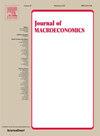货币和住房信贷政策之间的时变相互作用
IF 1.5
3区 经济学
Q3 ECONOMICS
引用次数: 0
摘要
长期以来,美国联邦政府一直通过各种机构,尤其是政府支持企业(gse),在抵押贷款市场发挥着关键作用。这些机构在住房信贷政策领域的重要性在20世纪90年代和大衰退之前的几年里有所增加。本文考察了货币政策对抵押贷款信贷的时变效应,重点研究了20世纪90年代初至2014年住房信贷政策的作用。使用时变参数向量自回归模型和高频货币政策意外,我表明gse在二级抵押贷款市场的活动塑造了抵押贷款来源对货币政策冲击的反应。随着政府支持企业更多地参与住房政策,抵押贷款再融资发起和政府支持企业购买抵押贷款对货币政策的反应增强。这表明,紧缩的货币政策,通过破坏住房政策目标和增加抵押贷款购买的盈利机会,可能会促使gse做出更强烈的反应,这反过来又会抑制货币政策收紧对住房活动的不利影响。本文章由计算机程序翻译,如有差异,请以英文原文为准。
Time-varying interactions between monetary and housing credit policy
The US federal government has long played a pivotal role in the mortgage market through various agencies, most notably the government-sponsored enterprises (GSEs). The importance of these agencies in the housing credit policy landscape increased during the 1990s and in the years leading up to the Great Recession. This article examines the time-varying effects of monetary policy on mortgage credit, focusing on the role of housing credit policy from the early 1990s to 2014. Using a time-varying parameter vector autoregression model and high-frequency monetary policy surprises, I show that GSEs’ activity in the secondary mortgage market has shaped the response of mortgage originations to monetary policy shocks. As GSEs became more involved in housing policy, the response of mortgage refinancing originations and GSEs’ mortgage purchases to monetary policy strengthened. This suggests that contractionary monetary policy, by undermining housing policy objectives and increasing profit opportunities from mortgage purchases, may prompt a stronger response from GSEs, which in turn dampens the adverse effects of monetary policy tightening on housing activity.
求助全文
通过发布文献求助,成功后即可免费获取论文全文。
去求助
来源期刊

Journal of Macroeconomics
ECONOMICS-
CiteScore
2.50
自引率
7.10%
发文量
53
审稿时长
76 days
期刊介绍:
Since its inception in 1979, the Journal of Macroeconomics has published theoretical and empirical articles that span the entire range of macroeconomics and monetary economics. More specifically, the editors encourage the submission of high quality papers that are concerned with the theoretical or empirical aspects of the following broadly defined topics: economic growth, economic fluctuations, the effects of monetary and fiscal policy, the political aspects of macroeconomics, exchange rate determination and other elements of open economy macroeconomics, the macroeconomics of income inequality, and macroeconomic forecasting.
 求助内容:
求助内容: 应助结果提醒方式:
应助结果提醒方式:


